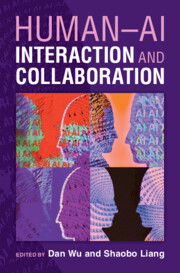Book contents
- Human–AI Interaction and Collaboration
- Reviews
- Human–AI Interaction and Collaboration
- Copyright page
- Contents
- Contributors
- Preface
- 1 Introduction
- 2 User Interaction for Human–AI Interaction and Collaboration
- 3 Privacy Identification of Human–Generative AI Interaction
- 4 Credibility Assessment of Human–Generative AI Interaction
- 5 AI-supported Crowdsourcing for Knowledge Sharing
- 6 AI-supported Search Interaction for Enhancing Users’ Understanding
- 7 AI for Human and Misinformation Interactions
- 8 Effective Human–AI Collaborative Intelligence
- 9 Human–AI Collaboration for Identifying Health Information Wants
- Chapter 10 Human–AI Collaboration for Scientific Discovery
- 11 Challenges of Generative AI on Human–AI Interaction and Collaboration
- 12 Conclusion
- References
2 - User Interaction for Human–AI Interaction and Collaboration
Published online by Cambridge University Press: 19 September 2025
- Human–AI Interaction and Collaboration
- Reviews
- Human–AI Interaction and Collaboration
- Copyright page
- Contents
- Contributors
- Preface
- 1 Introduction
- 2 User Interaction for Human–AI Interaction and Collaboration
- 3 Privacy Identification of Human–Generative AI Interaction
- 4 Credibility Assessment of Human–Generative AI Interaction
- 5 AI-supported Crowdsourcing for Knowledge Sharing
- 6 AI-supported Search Interaction for Enhancing Users’ Understanding
- 7 AI for Human and Misinformation Interactions
- 8 Effective Human–AI Collaborative Intelligence
- 9 Human–AI Collaboration for Identifying Health Information Wants
- Chapter 10 Human–AI Collaboration for Scientific Discovery
- 11 Challenges of Generative AI on Human–AI Interaction and Collaboration
- 12 Conclusion
- References
Summary
It is of great importance to integrate human-centered design concepts at the core of both algorithmic research and the implementation of applications. In order to do so, it is essential to gain an understanding of human–computer interaction and collaboration from the perspective of the user. To address this issue, this chapter initially presents a description of the process of human–AI interaction and collaboration, and subsequently proposes a theoretical framework for it. In accordance with this framework, the current research hotspots are identified in terms of interaction quality and interaction mode. Among these topics, user mental modeling, interpretable AI, trust, and anthropomorphism are currently the subject of academic interest with regard to interaction quality. The level of interaction mode encompasses a range of topics, including interaction paradigms, role assignment, interaction boundaries, and interaction ethics. To further advance the related research, this chapter identifies three areas for future exploration: cognitive frameworks about Human–AI Interaction, adaptive learning, and the complementary strengths of humans and AI.
Information
- Type
- Chapter
- Information
- Human-AI Interaction and Collaboration , pp. 14 - 42Publisher: Cambridge University PressPrint publication year: 2025
References
Accessibility standard: WCAG 2.2 AAA
Why this information is here
This section outlines the accessibility features of this content - including support for screen readers, full keyboard navigation and high-contrast display options. This may not be relevant for you.Accessibility Information
Content Navigation
Allows you to navigate directly to chapters, sections, or non‐text items through a linked table of contents, reducing the need for extensive scrolling.
Provides an interactive index, letting you go straight to where a term or subject appears in the text without manual searching.
Reading Order & Textual Equivalents
You will encounter all content (including footnotes, captions, etc.) in a clear, sequential flow, making it easier to follow with assistive tools like screen readers.
You get concise descriptions (for images, charts, or media clips), ensuring you do not miss crucial information when visual or audio elements are not accessible.
You get more than just short alt text: you have comprehensive text equivalents, transcripts, captions, or audio descriptions for substantial non‐text content, which is especially helpful for complex visuals or multimedia.
Visual Accessibility
You will still understand key ideas or prompts without relying solely on colour, which is especially helpful if you have colour vision deficiencies.
You benefit from high‐contrast text, which improves legibility if you have low vision or if you are reading in less‐than‐ideal lighting conditions.
